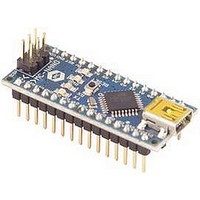MC-NANO MULTICOMP, MC-NANO Datasheet - Page 2

MC-NANO
Manufacturer Part Number
MC-NANO
Description
Arduino NANO Based Board W/ ATMEGA328
Manufacturer
MULTICOMP
Datasheet
1.MC-NANO.pdf
(3 pages)
Specifications of MC-NANO
Silicon Manufacturer
Atmel
Core Architecture
AVR
Features
Mini-B USB Cable, 6 To 20V Unregulated External Power Supply
Kit Contents
Development Board Only
Silicon Family Name
Atmega
Silicon Core Number
ATmega328
Rohs Compliant
Yes
Lead Free Status / RoHS Status
Lead free / RoHS Compliant
Memory
The ATmega328 has 32KB (with 2KB used for the bootloader). The ATmega328 has 2KB of SRAM and 1KB of EEPROM. (which
can be read and written with the EEPROM library).
Input and Output
Each of the 14 digital pins on the Nano can be used as an input or output, using pinMode(), digitalWrite(), and digitalRead()
functions. They operate at 5 volts. Each pin can provide or receive a maximum of 40mA and has an internal pull-up resistor
(disconnected by default) of 20 to 50k ohms. In addition, some pins have specialized functions:
•
•
•
•
•
The Nano has 8 analog inputs, each of which provide 10 bits of resolution (i.e. 1024 different values). By default they measure from
ground to 5 volts, though is it possible to change the upper end of their range using the analogReference() function. Additionally,
some pins have specialized functionality:
•
There are a couple of other pins on the board:
•
•
Communication
The MC-NANO has a number of facilities for communicating with a computer, another board, or other microcontrollers. The
ATmega328 provide UART TTL (5V) serial communication, which is available on digital pins 0 (RX) and 1 (TX). An FTDI FT232RL
on the board channels this serial communication over USB and the FTDI drivers (included with the Arduino™ software) provide a
virtual com port to software on the computer. The Arduino™ software includes a serial monitor which allows simple textual data to
be sent to and from the Arduino™ board. The RX and TX LEDs on the board will flash when data is being transmitted via the FTDI
chip and USB connection to the computer (but not for serial communication on pins 0 and 1).
A SoftwareSerial library allows for serial communication on any of the Nano's digital pins.
The ATmega328 also support I2C (TWI) and SPI communication. The Arduino™ software includes a Wire library to simplify use of
the I2C bus; see the documentation for details. To use the SPI communication, please see the ATmega328 datasheet.
MC-NANO
Arduino™ Nano Compatible Development Board
http://www.farnell.com
http://www.newark.com
http://www.cpc.co.uk
Serial: 0 (RX) and 1 (TX). Used to receive (RX) and transmit (TX) TTL serial data. These pins are connected to the
corresponding pins of the FTDI USB-to-TTL Serial chip.
External Interrupts: 2 and 3. These pins can be configured to trigger an interrupt on a low value, a rising or falling edge, or
a change in value. See the attachInterrupt() function for details.
PWM: 3, 5, 6, 9, 10, and 11. Provide 8-bit PWM output with the analogWrite() function.
SPI: 10 (SS), 11 (MOSI), 12 (MISO), 13 (SCK). These pins support SPI communication, which, although provided by the
underlying hardware, is not currently included in the Arduino™ language.
LED: 13. There is a built-in LED connected to digital pin 13. When the pin is HIGH value, the LED is on, when the
pin is low, it's off.
I
AREF. Reference voltage for the analog inputs. Used with analogReference().
Reset. Bring this line LOW to reset the microcontroller. Typically used to add a reset button to shields which block the
one on the board.
2
C: 4 (SDA) and 5 (SCL). Support I
2
C (TWI) communication using the Wire library (documentation on the Wiring website).
Page <2>
28/05/10 V1.1









